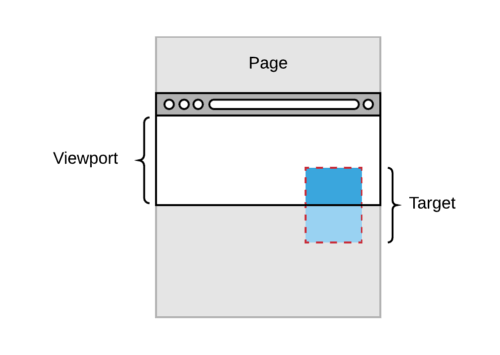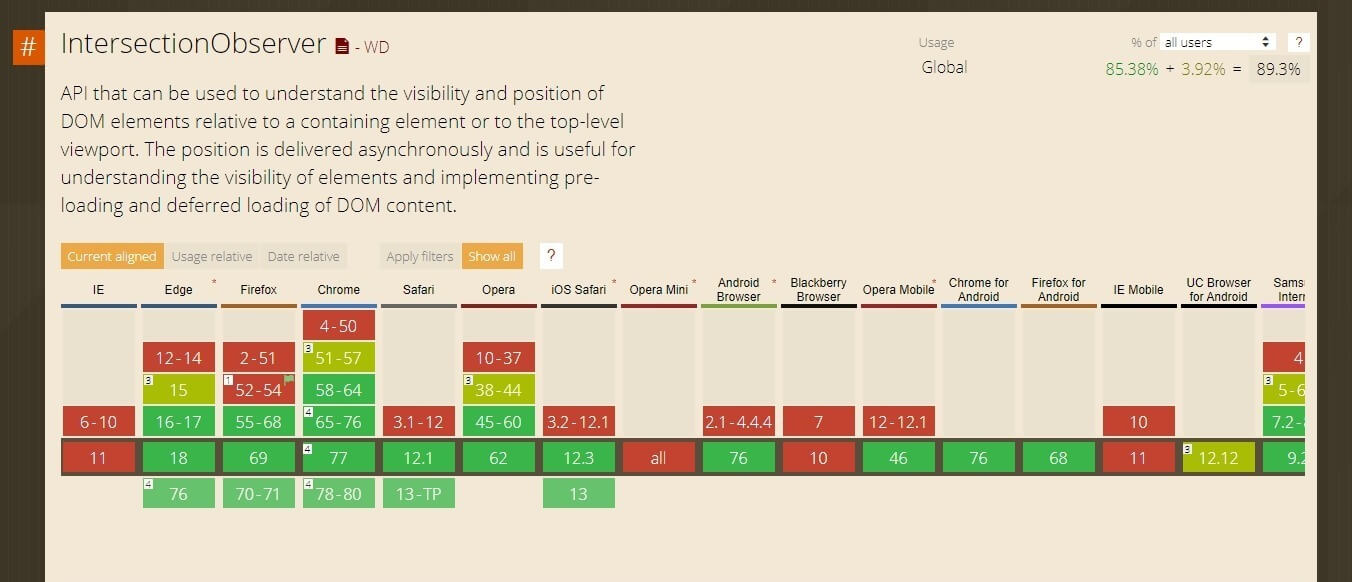A tale of Intersection Observer.
What if i tel you that lazy loading for images and entry animation or scroll animations don’t require external plugin’s or fallback plugins to work and can be done with a simple API, how does that sound? 😌
The Intersection Observer API provides a way to asynchronously observe changes in the intersection of a target element with an ancestor element or with a top-level document’s viewport.
Definition
To describe what an observer is
Observers are objects that spot something in real-time like birdwatching 👀
Overview(Concept and usage)
There’s a good support for Intersection Observer API as of today you can check caniuse
You can check if API is supported in the browser
if(!!window.IntersectionObserver){}
// or
if('IntersectionObserver' in window){}Create the intersection observer by calling its constructor and passing it a callback function to be run whenever a threshold is crossed in one direction or the other:
let options = {
root: document.querySelector('#scrollArea'),
rootMargin: '0px',
threshold: 1.0
}
let observer = new IntersectionObserver(callback, options);Options has three properties:
root - The ancestor element/viewport that the observed element will intersect. Think of it as the train station that the train will intersect.
rootMargin - A perimeter of the root element, shrinking or growing the root element’s area to watch out for intersection. It’s similar to the CSS margin property.
threshold - An array of values (between 0 and 1.0), each representing the distance an element has intersected into or crossed over in the root at which the callback is to be triggered.
Function to check if viewport hit the root with observer and call lazy load function to work. This works with background-image too!!!
function lazyLoader(entries) {
// loop through all images
entries.forEach(function (entry) {
// does the viewport hit the current image
if (entry.intersectionRatio > 0) {
// yes! load the image
lazyLoadImage(entry.target);
}
});
}
function lazyLoadImage(observedImage) {
/**
* We hit an observed image!
* First, remove the lazy loading class. This will show the image
* Then remove the observer
*/
observedImage.classList.remove('lazyImage'); // If we have an background image, replace the source with the data-lazyBackground attribute
if (observedImage.dataset.lazybackground) {
observedImage.style.backgroundImage = "url(".concat(observedImage.dataset.lazybackground, ")");
} // does it have a data attribute with image-src?
if (observedImage.getAttribute('data-src')) {
// yes! So lets make the image source equal to the data image source and render it!
observedImage.src = observedImage.dataset.src;
if ('IntersectionObserver' in window) {
// now that the image has bee renderes, we don't need to observe it anymore
observer.unobserve(observedImage);
}
}
}More in-depth details can be found at MDN
Entire working code can be found here with class lazyImage for any effect or separate triggering.
For those browsers which doesn’t support this API it sets data-src to src straight. 😉
var options = {
rootMargin: '0px',
threshold: 0.1
};
var allTheLazyImages = Array.prototype.slice.call(document.querySelectorAll('.lazyImage'), 0);
var observer; // Does your browser support InersectionObserver?
if ('IntersectionObserver' in window) {
observer = new IntersectionObserver(lazyLoader, options); // select all our image which we want to have lazy loaded
allTheLazyImages.forEach(function (image) {
// put them in the observer
observer.observe(image);
});
} else {
allTheLazyImages.forEach(function (image) {
lazyLoadImage(image); // if it is not supported, load all
});
}
function lazyLoader(entries) {
// loop through all images
entries.forEach(function (entry) {
// does the viewport hit the current image
if (entry.intersectionRatio > 0) {
// yes! load the image
lazyLoadImage(entry.target);
}
});
}
function lazyLoadImage(observedImage) {
/**
* We hit an observed image!
* First, remove the lazy loading class. This will show the image
* Then remove the observer
*/
observedImage.classList.remove('lazyImage'); // If we have an background image, replace the source with the data-lazyBackground attribute
if (observedImage.dataset.lazybackground) {
observedImage.style.backgroundImage = "url(".concat(observedImage.dataset.lazybackground, ")");
} // does it have a data attribute with image-src?
if (observedImage.getAttribute('data-src')) {
// yes! So lets make the image source equal to the data image source and render it!
observedImage.src = observedImage.dataset.src;
if ('IntersectionObserver' in window) {
// now that the image has bee renderes, we don't need to observe it anymore
observer.unobserve(observedImage);
}
}
}

